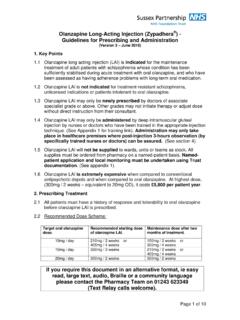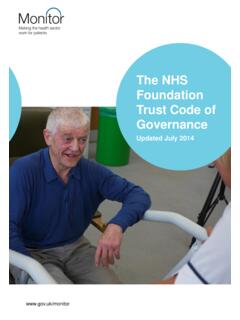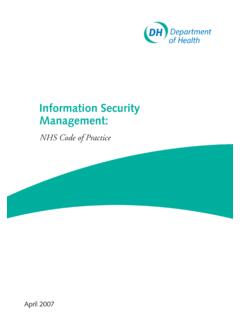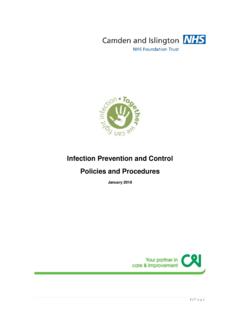Transcription of The Rapid Tranquillisation Policy (Including the use of ...
1 Rapid Tranquillisation Policy A member of: Association of UK University Hospitals The Rapid Tranquillisation Policy (Including the use of oral PRN medication). (Replaces Policy No. TP/CL/018 ). (The Use of Medication in the Control of Acutely Disturbed or Violent Behaviour). (This Policy applies to Working Age Adult, Secure & Forensic, Specialist Women's, Older People's, Children & Young Peoples, and Learning Disability Services). Policy NUMBER TP/CL/018. VERSION RATIFYING COMMITTEE Professional Policy Forum DATE RATIFIED 02 November 2018. EQUALITY & HUMAN RIGHTS 01 March 2011. IMPACT ASSESSMENT. NEXT REVIEW DATE 02 November 2020. EXECUTIVE SPONSOR Chief Medical Officer Policy AUTHORS Principal Pharmacist Deputy Chief Pharmacist Lead Pharmacist Chief Pharmacist (Governance).
2 Executive Summary: When to consider using Rapid Tranquillisation and the process to follow, including record keeping, monitoring and training. Consideration of advance decisions/statements. Specific risk issues. If you require this document in another format such as large print, audio or other community language please contact the Corporate Governance Team on: 0300 304 1195 or email: Page 1 of 47. Rapid Tranquillisation Policy CONTENTS. PAGE. Introduction 4. Purpose of Policy 4. Scope of Policy 4. Definition 4. Principles 4. Equality Impact Assessment 5. Training Expectations 5. Policy Statement 6. Policy & Procedural Practice 6. Key Priorities 6. Mental Health Act Considerations 7. Rapid Tranquillisation & Seclusion 8.
3 Overview of the Short-Term Management of Disturbed/Violent 9. Behaviour Medication 10. Treatment Aims 10. Oral Medication for Acute Severe Agitation 10. Rapid Tranquillisation Medication 12. High Doses 15. Administration of Medication 16. Monitoring the Patient & Recording 17. Medication Specific Risks 19. Discontinuation of Rapid Tranquillisation 19. Advance Decisions & Statements 19. Algorithm 1 RT in working Adult 20. Algorithm 2 RY in Older Person >65 years (excluding Dementia) 22. Algorithm 3 RT in Dementia Services 24. Algorithm 4 RT in Child & Adolescent 26. Algorithm 5 RT in Learning Disabilities 28. Page 2 of 47. Rapid Tranquillisation Policy Specialist Advice for Working Outside the Appropriate 30. Algorithm Intravenous Therapy 31.
4 Responsibilities 31. Overview 31. The trust 31. Medical & Nursing Professional Leads 31. trust Pharmacy Team 31. Ward Managers & Modern Matrons 32. Consultants 32. Individual Clinical Staff 32. Monitoring Compliance with the Policy 33. Development, Consultation & Ratification 33. Dissemination & Implementation of the Policy 33. Document Control Including Archive Arrangements 34. References 34. Other trust Policies to be Cross-Referenced 34. Appendices Appendix 1 Physical Health Monitoring & Remedial Measures 36. Appendix 2 News RT Monitoring Protocol 37. Appendix 3 Guidelines for Administration of Flumazenil 39. Appendix 4 Broset Violence Checklist 40. Appendix 5 Specialist Advice Medicines 42. Appendix 6 Pharmacokinectics 43.
5 Appendix 7 Drugs Known to Prolong QT Level 44. Appendix 8 Glossary of Terms 45. Page 3 of 47. Rapid Tranquillisation Policy 1. INTRODUCTION. Purpose of this Policy . The purpose of this document is to provide staff working in Sussex Partnership NHS. Foundation trust wards with guidance about the use of Rapid Tranquillisation (RT). It sets out the main provisions of appropriate use of RT, use of associated medication and the roles and responsibilities of staff. Scope of this Policy . This document applies to all qualified medical and nursing staff (and non-medical prescribers) involved in the prescribing and/or administration of medication for RT. This includes staff employed by the trust and also those healthcare staff who are either seconded or contracted to the trust .
6 The document covers the treatment of inpatients in working age adult services, secure and forensic services, specialist women's services, older people's services and children and young people's services. Currently this document does not cover patients with a primary diagnosis of substance misuse, behaviour difficulties in Alzheimer's disease or delirium. Definition. Rapid Tranquillisation (RT) is the use of medication by the parenteral route (usually intramuscular or exceptionally, intravenous) if oral medication is not possible or appropriate and urgent sedation with medication is needed (NICE NG10) (BAP 2018). Principles. RT is to calm a patient who is exhibiting acutely disturbed or violent behaviour. It is intended to reduce the risk of harm to the patient and also to other patients and members of staff by reducing agitation and aggression.
7 The optimal delivery of RT will allow further psychiatric evaluation to take place and will not compromise patient comprehension or their ability to respond to spoken messages or instruction. RT should only be considered once de-escalation and other strategies have failed to calm the patient. (See section ). The intervention (along with physical intervention and seclusion) should be considered a management strategy and not be regarded as a primary treatment technique. When determining which intervention to employ, clinical need, the safety of service users and others and, where possible, any Advance Decisions or Advance Statements should always be taken into account. The intervention selected must be a reasonable and proportionate response to the risk posed by the patient at that particular time.
8 The reasons for using RT (and any other intervention) must always be explained to the patient at the earliest opportunity and documented in the clinical record. Page 4 of 47. Rapid Tranquillisation Policy Equality Impact Assessment. (Undertaken in March 2011). All patients covered by this Policy , regardless of their race, gender, gender identity, sexuality, religion, spiritual beliefs or disability, will be treated equally within the principles of the Policy and with equal dignity and respect. Training Expectations. A full understanding of the Rapid Tranquillisation Policy is essential for all qualified staff that may be called upon to prescribe and/or administer medication in response to situations described in the Violence and Aggression (PMVA) the Prevention and Management of Policy .
9 These two documents should be read in conjunction. Staff must also be familiar with the Resuscitation and Anaphylaxis Policy and the Observation Policy . It is deemed essential that all qualified medical and nursing staff working in inpatient units be trained in the use of RT (based on the treatment algorithm most suitable for their unit), as per trust training schedule. The responsibility to ensure adequate training is undertaken lies with ward managers and modern matrons (for nursing staff) and with consultants and local tutors (for medical staff) and should extend to include locum, agency and bank staff. The training requirement for RT varies according to whether the member of staff is a doctor (or non-medical prescriber) or a nurse.
10 All new medical staff should successfully complete the specific trust My Learning module training in RT as part of their induction training, whether working in community or hospital if they are expected to cover inpatient units as part of their on-call duties. Nursing staff working on wards in substantive or bank' posts will undertake RT. training as a specific My Learning module and receive a brief update as part of their Medicines Management Update day. Ward managers and matrons will ensure that each member of their nursing staff has undertaken and successfully completed the e-learning module. Newly qualified staff will also be expected to pass the RT. competencies as outlined in the trust Preceptorship Policy . Wherever possible, RT training will be accessed within three months of commencing an inpatient role.













